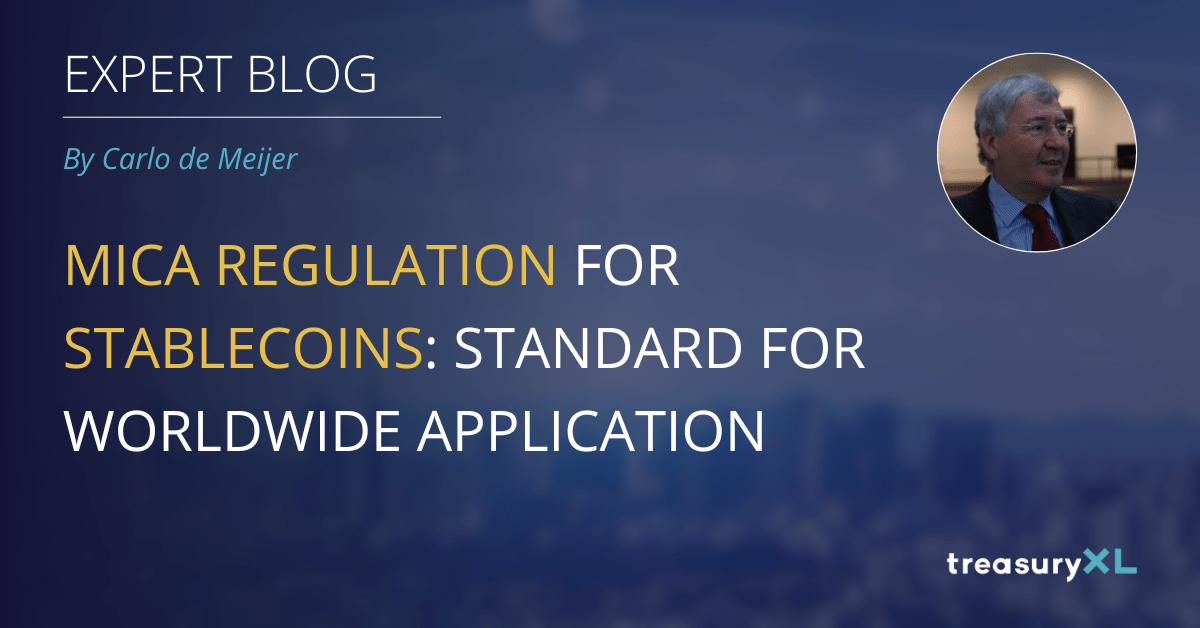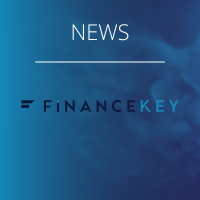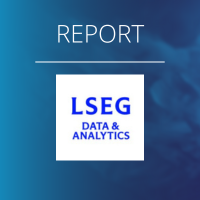In this blog we will go into more detail what this new regulation entails in terms of requirements for stablecoin issuers. What will this regulation mean for non-authorised stablecoins like Tether, USDC, DAI, and others, that nowadays are dominating the crypto market. We also look at the initial reactions by stablecoin issuers, as well as the impact on stablecoins. What will this regulation mean what will this mean for stablecoin regulations worldwide and how will the future stablecoin market look like.
MICA Regulation
The implementation of the Markets in Crypto-assets (MiCA) regulation for stablecoins in Europe on June 30 is seen as a landmark development in the stablecoin market. This event represents the first step of the MiCA regulation, the EU’s comprehensive package of unified rules for the crypto industry across the EU, that was voted into law last year.
MiCA, will be implemented in phases, with full compliance required by the end of the year, when Mica’s remaining obligations impacting crypto asset service providers (CAPs) will come into effect.
This regulatory framework is designed to unify the fragmented regulatory environment across Europe and is aimed to preserve financial stability and protect investors from the potential risks of unbacked crypto-assets and stablecoins, while fostering innovation in the crypto sector.
MICA Stablecoin Regulation: key objectives
The key objectives of MiCA for stablecoins are: to replace individual regulations present in various countries with one unifying and comprehensive EU framework; to set clearer rules for stablecoin issuers; and provide more certainty in the regulation of stablecoins, which are not covered by existing financial regulations.
MiCA stablecoin regulations aims to enhance market integrity, ensure market stability, ensure consumer protection, and foster innovation within the stablecoin Market.
Compared to other global regions, the EU’s approach is notably rigorous. The EU’s MiCA encompasses a broader scope, including comprehensive/prudential requirements for stablecoin issuers and specific rules for significant stablecoins.
MiCA seeks to establish mechanisms that ensure stablecoins remain pegged to the asset that they track, provide enhanced transparency and prevent market players from creating excessive risk, while also ensuring that the assets under custody are protected.
Why the MICA Regulation for stablecoins?
Some of the developments in the crypto world over the past recent months might suggest that these assets are not so stable after all. Even though stablecoins have not seriously jeopardized the financial stability in the euro area yet, this could easily change given the pace at which these assets grow. Stablecoins currently dominate the crypto market, accounting for 60% of on-chain transaction volume in 2023, highlighting their critical role in digital asset transactions. For that reason appropriate regulatory, supervisory and oversight frameworks need to be implemented urgently before stablecoins become a risk to financial stability.
The MICA regulation of stablecoin by the EU is aimed to bring regulatory clarity and reduce risk for market participants, by creating a unifying and comprehensive framework for all countries of the EU. By establishing clear and transparent rules and compliance requirements, the EU aims to protect consumers and ensure the stability of the financial and monetary system.
How are Stablecoins classified in MICA?
In MiCA regulation stablecoins are classified into two main types as a means of payment and exchange: e-money tokens (EMTs) and asset-referenced tokens (ARTs). EMTs are crypto-assets that aim to stabilize their value by referencing a single official currency, like the dollar or the euro. They function similarly to electronic money. Fiat-backed stablecoins like Tether’s USDT and Circle’s USD Coin fall within this category. And there are the ARTs, each with specific regulatory requirements for issuers. These stablecoins aim to stabilize their value by referencing multiple assets, such as a basket of currencies, commodities, or other crypto assets. Examples are DAI and PAXCG.
MICA Compliance Roadmap: requirements
Issuers of these stablecoins subject to strict licensing requirements under MiCA for qualifying as electronic money institutions or credit institutions. Next to that Issuers of regulated stablecoins will have to meet detailed requirements on transparency, asset reserves, risk management and continuous reporting obligations.
These safeguards are intended to increase consumer confidence in digital currencies by ensuring that stablecoins can be used as a store of value and for payments in a dependable manner.
License
From June 30, 2024, issuance of stablecoins in the EU is restricted to approved institutions. Only companies complying with the requirements imposed by MiCA will be authorised to issue and offer stablecoins in the EEA.
All stablecoin issuers operating in the EU are required to obtain a license as credit institutions or Electronic Money Institutions under the MiCA framework. Companies issuing stablecoins within the EEA, including e-Money issuers and issuers of asset referenced stablecoins, will therefor need to go through a licensing procedure. A National Competent Authority (NCA) within an EU country will thereby conduct the authorization procedure. Large issuers operating in offshore jurisdictions will need to establish in the EU to remain compliant
White Paper
For stablecoin issuers to become compliant they must provide a white paper including information such as: details of the issuer and the nature of the project; the rights and obligations attached to the token offering; the nature of the underlying technology; and the risks the issuer anticipates could arise from the issuance of their token. This white paper must be approved by the home member state national competent authority.
Ensure ongoing compliance
In addition to submitting a whitepaper, issuers must have in place a robust program to ensure ongoing compliance with regulatory standards designed to mitigate risks and minimize harm to holders of their stablecoins. To achieve compliance with MiCA, issuers must establish a risk management framework that relies upon comprehensive policies and procedures, strong governance arrangements, and carefully designed systems and controls.
Stringent regulatory requirements
Stablecoin issuers must meet a range of strict regulatory requirements of transparency, compliance and reserves prior to offering their tokens to consumers within the EU. They should impose strict rules regarding fiat backing, redeemability, transparency, and security for stablecoins.
The regulation requires stablecoin providers to maintain adequate reserves. The stablecoin must be backed by low-risk, liquid investments to ensure the stability of their coins. Issuers of stablecoins must guarantee that the reserve assets are safely and effectively managed, segregated from the issuer’s own assets, and not pledged as collateral. Regular reporting to the respective NCA about the status of assets is mandatory.
Transaction limits
To address potential systemic risks, more stringent requirements are to be applied to “significant stablecoins” that could pose a greater threat to financial stability, monetary policy transmission and monetary sovereignty.
The MiCA provisions impose strict trading limits on certain significant stablecoins that are used as a means of exchange. Caps are imposed on daily transaction values for ARTs and non-euro currency-denominated EMTs.
The caps on issuance and transactions for certain USD-referenced “e-money” tokens — including USDT, USDC, and BUSD — are set at 1 million daily transactions by volume or 200 million euros by notional value a day. Companies must stop issuing non-euro denominated stablecoins if they exceed these caps.
Oversight
Stablecoin issuers should undertake regular reporting to their relevant national supervisory authority. EMT issuers are subject to oversight by the European Banking Authority (EBA), while ART issuers are subject to oversight by the European Securities and Markets Authority (ESMA), except where they are deemed to be “significant” in scale, in which case they are subject to supervision by the European Banking Authority (EBA).
Full compliance: e-Mony licence
At the moment of writing this blog there are still a number stablecoin issuers that already have obtained an e-Money licence to operate legally in the EU, including names like Circle, StablR, and SG-Forge.
Circle
On 30 June, US-based stablecoin issuer Circle reported its full compliance with MiCA. The company thereby became the first global stablecoin issuer to secure an Electronic Money Institution (EMI) license under the EU’s MiCA regulatory framework, enabling it to passport its licence within the EU. Circle announced that its two main stablecoins, USDC and EURC, are now regulatory compliant under the new rules and available under new European regulations. As a France-registered EMI, Circle Mint France will “onshore” the issuance of its euro-denominated EURC stablecoin, to the EU and issue USDC from the same entity, offering its services to customers across the EU.
StablR
StablR, a European digital asset firm based in Malta, focused on providing efficient, secure, and transparent euro-denominated stablecoin services, has announced the acquisition on July 1, 2024 of an EMI License and the subsequent launch of its MiCA-compliant euro-denominated stablecoin, EURR. This license allows StablR to issue EURR, positioning it next to Circle, as one of the first fully compliant euro-backed stablecoins in the post-MiCA landscape.
SG-Forge
Société Generale – Forge (SG-Forge), a subsidiary of Société Generale, also announced that it had obtained an e-Money license, and that its EURCV stablecoin is now classified as electronic money tokens under MICA. SG-Forge has complied with the MiCA regulations by the removal of whitelist restrictions via updating its smart contracts. This update is mainly to speed up settlement, enhance security, and expand its application scope on public blockchains. This enables EURCV to be used in a wider market while providing more liquidity and usage scenarios.
Now that these stablecoin issuers has taken this step and obtained an e-Money license, we might see other stablecoin companies trying to get similar approval in Europe. This could give people more choices if they want to use stablecoins.
First reactions of major exchange platforms: delistings
By being strict with stablecoins tied to the US dollar, MiCA runs the risk of deeming many existing coins as non-compliant, being forced to leave the EU market. Many crypto exchanges operating within the EU have already taken action ahead of the new rules entering into force. They announced changes to their stablecoin policies and product offerings, while creating significant opportunities for licensed e-money platforms.
Major crypto exchanges like Uphold, Binance, Bitstamp, Kraken, and OKX have already started to delist no-compliant stablecoins for their European customers such as Tether and DAI or have begun implementing restrictions on services for EU and European Economic Area-based users, while others committing to do so in the coming months.
Uphold
In June Uphold, a New York-based crypto exchange and custodial platform, has announced its decision to discontinue support for a number of stablecoins in preparation for the MICA regulations. These include names like Tether, FRAX, GUSD, USD and TUSD. Starting July 1, 2024, these digital assets will no longer be available on the Uphold platform. Users holding these stablecoins were encouraged to convert them to a different cryptocurrency before June 28, after which the cryptocurrency exchange would automatically convert them into USD Coin. If not converted by this deadline, these stablecoins would automatically be exchanged for Circle’s USD.
Binance
Binance, the world’s largest centralized exchange, likewise took a similar but softer approach to the new stablecoin regulations by adopting a “sell-only” strategy for certain unauthorised stablecoin products in the European market. To comply with the new regulations, Binance has outlined a “phased” approach, thereby revealing plans to restrict the use of unauthorised stablecoins on its platform that don’t meet MiCA standards from June 26.
The platform thereby asked its users to switch to stablecoins that meet MiCA’s requirements. After that date, any remaining open positions will be automatically closed at market price, and assets will be transferred to spot wallets. From June 30, Binance also stop supporting various other important services if they rely on unregulated stablecoins.
Binance explained that it would not delist any stablecoins at this time for its European users until further notice, opting instead to label the fiat equivalents as either compliant or non-compliant and limiting certain market features for European customers.
Kraken
Kraken, the US based crypto platform, is still evaluating the implications for stablecoins such as USDT on their platforms, with decisions pending on whether to continue listing them. The exchange is thereby preparing for various scenarios, including discontinuing support for certain tokens.
Kraken is currently reviewing Tether’s compliance with the new EU regulations and has not yet decided on the future listing of USDT, as it assesses the implications of MiCA. Kraken has no plans to delist Tether’s USD stablecoin (USDT) from its European platform at this time. However, the company will follow all legal requirements.
OKX
Crypto exchange OKX has delisted Tether USDT trading pairs in Europe already in March due to impending stablecoin regulations, saying it wanted to focus on euro-denominated liquidity in the region. OKX continued to offer other stablecoins like USDC and euro-based pairs. The delisting will enable the exchange to introduce euro on-ramps for EEA-based customers. OKX has selected Malta as its MiCA hub for Europe.
First reactions: USDC versus USDT
The impact of MiCA regulation is already seen on the stablecoin markets. The share of compliant stablecoins, has increased over the past few months, suggesting increased demand for transparency and regulated alternatives.
Tether USDT’s market share dropped
Up till now this year Tether’s USDT market share on centralized exchanges (CEXs) decreased from 82% to 74% triggered by the new MiCA stablecoin regulation. This decline highlights the growing competition in the stablecoin market and the potential regulatory challenges facing Tether. Notwithstanding the drop in market share, Tether (USDT) still remains the most widely used stablecoin, with a market capitalization of over $100 billion.
Circle’s USDC and EURC on the rise
The implementation of the MiCA regulation has driven up demand for compliant stablecoins. This trend especially favoured US based payments firm Circle’s USDC and EURC. Both stablecoins have seen strong increase in volume. In 2024, USDC’s trading volume surged to a record-breaking weekly size of $23B from $9B in 2023. This exponential growth arises amid higher demand for legally accepted stablecoins among major traders. This rise has positioned USDC close to rival Hongkong FDUSD, with a nearly 14% market share in the stablecoin sector.
Next to the compliance to MIC regulation various market factors have been driving USDC’s trading volume and market share. The rise of CEXes (centralised exchanges) are a central factor driving USDC volume, challenging non-compliant counterparts in the stablecoin market. Equally, perpetual futures settlements have played a critical role in surging trading volume, though it is still very low compared to Tether’s USDT.
Circle launched EURC on the Base network
Another event that favoured Circle’s stablecoins is that the company has launched its euro-backed stablecoin EURC on the Base network, an Ethereum layer-2 solution. EURC and USDC on Base are claimed to be the first MiCA-compliant stablecoins from a global issuer on the network. This compliance is crucial as regulatory scrutiny of cryptocurrencies and stablecoins intensifies globally. The introduction of EURC to Base is expected to bring several benefits to users and developers. These include the ability to facilitate near-instant cross-border payments and marketplace payouts at a significantly lower cost than traditional systems. Furthermore, the stablecoins provide round-the-clock access to the decentralized finance (DeFi) ecosystem.
Compliant versus non-compliant stablecoins: rebalance
Although unregulated stablecoins are still dominating the crypto markets with 88% of total stablecoin volume (in terms of market capitalisation), the future of regulated stablecoins seems bright.
MiCA could shift this balance as exchanges and market makers increasingly favour compliant stablecoins, including Circle’s USDC and EURC, over non-compliant alternatives in the US, such as USDT, XRP, Uniswap and Monero facing legal hurdles.
Noncompliant stablecoin issuers could be subject to face restrictions potentially forced to exit the EU market entirely. The non-compliance of Tether and the delisting of USDT by a number of crypto exchanges could lead to a diminution of USDT liquidity in Europe.
The MICA framework could dramatically increase the importance of compliant stablecoins to become a mainstream financial instrument. With the demand further pick up in European markets, fuelled by the tighter regulations, this may especially favour compliant MiCA stablecoins such as the USDC, long been the second-largest stablecoin worldwide. This could especially hurt Tethers market leading USDT, the world\s largest stablecoin by market capitalisation.
MiCA’s Stablecoin Regime: remaining challenges.
As the MiCA regime for stablecoins has come into force, there are still some relevant points to be considered. MiCA still leaves some room for interpretation and uncertainty, alongside current practical challenges.
There is some uncertainty around the opportunities for trading of non-MiCA authorized stablecoins for future CASPs, particularly in light of MiCA’s CASP provisions only taking effect on 30 December 2024.
For the most part, MiCA compliance is supervised and enforced by EU national authorities. There remains uncertainty about how these theoretical rules will be practically understood and implemented by both firms and regulators.
MiCA’s effectiveness, and its ultimate success, will depend on a transparent and consistent implementation by national regulators across the EU and a clear understanding of regulatory expectations by firms.
Ongoing efforts by the EBA and ESMA to refine standards and guidelines are expected to provide much-needed clarity and ensure that all stakeholders can navigate the new regulatory landscape effectively, fostering a more robust and secure crypto asset market.
MICA stablecoin regulation as the international benchmark
MiCA’s stablecoin regime signifies a pivotal moment for the regulation of crypto assets in Europe. The detailed prudential and conduct requirements, alongside stringent governance and redemption rules, reflect the EU’s commitment to establishing a rigorous and comprehensive regulatory environment for stablecoins.
MiCA is expected to significantly impact the stablecoin market, both in the EU and globally. MiCA will undoubtedly serve as the standard bearer for crypto regulation, guiding other jurisdictions and economic blocs on how to regulate a burgeoning, complex, and volatile market that offers a lot of promise.
MiCA may serve as a model for other regions, setting a precedent for global regulatory standards. It may prompt other jurisdictions to adopt similar regulatory frameworks, leading to a more harmonized regulatory environment worldwide for crypto-assets. Already, the influence of MiCA can be seen in the development of legislation in the Asia-Pacific region (Hong Kong), the United Kingdom, and the United States.
This could facilitate cross-border transactions and interoperability between different regulatory regimes, further integrating the crypto market into the traditional global financial system.












